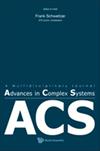Risk Awareness to epidemic Information and Self-Restricted Travel Behavior on Contagion
IF 1
4区 数学
Q4 MATHEMATICS, INTERDISCIPLINARY APPLICATIONS
引用次数: 1
Abstract
By incorporating delayed epidemic information and self-restricted travel behavior into the SIS model, we have investigated the coupled effects of timely and accurate epidemic information and people’s sensitivity to the epidemic information on contagion. In the population with only local random movement, whether the epidemic information is delayed or not has no effect on the spread of the epidemic. People’s high sensitivity to the epidemic information leads to their risk aversion behavior and the spread of the epidemic is suppressed. In the population with only global person-to-person movement, timely and accurate epidemic information helps an individual cut off the connections with the infected in time and the epidemic is brought under control in no time. A delay in the epidemic information leads to an individual’s misjudgment of who has been infected and who has not, which in turn leads to rapid progress and a higher peak of the epidemic. In the population with coexistence of local and global movement, timely and accurate epidemic information and people’s high sensitivity to the epidemic information play an important role in curbing the epidemic. A theoretical analysis indicates that people’s misjudgment caused by the delayed epidemic information leads to a higher encounter probability between the susceptible and the infected and people’s self-restricted travel behavior helps reduce such an encounter probability. A functional relation between the ratio of infected individuals and the susceptible-infected encounter probability has been found.疫情信息风险意识与传染病自限性出行行为
我们将延迟的疫情信息和自限出行行为纳入SIS模型,考察了及时准确的疫情信息和人们对疫情信息的敏感性对传染的耦合效应。在只有局部随机运动的人群中,疫情信息是否延迟对疫情的传播没有影响。人们对疫情信息的高度敏感导致了风险规避行为,抑制了疫情的传播。在只有全球人对人流动的人群中,及时准确的疫情信息有助于个人及时切断与感染者的联系,使疫情在第一时间得到控制。疫情信息的延迟导致个人对谁感染了谁没有感染的判断错误,这反过来又导致疫情迅速发展和更高的高峰。在本地和全球流动并存的人口中,及时准确的疫情信息和人们对疫情信息的高度敏感性对遏制疫情起着重要作用。理论分析表明,由于疫情信息的延迟,人们的误判导致易感者与感染者相遇的概率更高,而人们的自我限制出行行为有助于降低这种相遇的概率。发现了感染个体比例与易感感染相遇概率之间的函数关系。
本文章由计算机程序翻译,如有差异,请以英文原文为准。
求助全文
约1分钟内获得全文
求助全文
来源期刊

Advances in Complex Systems
综合性期刊-数学跨学科应用
CiteScore
1.40
自引率
0.00%
发文量
121
审稿时长
6-12 weeks
期刊介绍:
Advances in Complex Systems aims to provide a unique medium of communication for multidisciplinary approaches, either empirical or theoretical, to the study of complex systems. The latter are seen as systems comprised of multiple interacting components, or agents. Nonlinear feedback processes, stochastic influences, specific conditions for the supply of energy, matter, or information may lead to the emergence of new system qualities on the macroscopic scale that cannot be reduced to the dynamics of the agents. Quantitative approaches to the dynamics of complex systems have to consider a broad range of concepts, from analytical tools, statistical methods and computer simulations to distributed problem solving, learning and adaptation. This is an interdisciplinary enterprise.
 求助内容:
求助内容: 应助结果提醒方式:
应助结果提醒方式:


